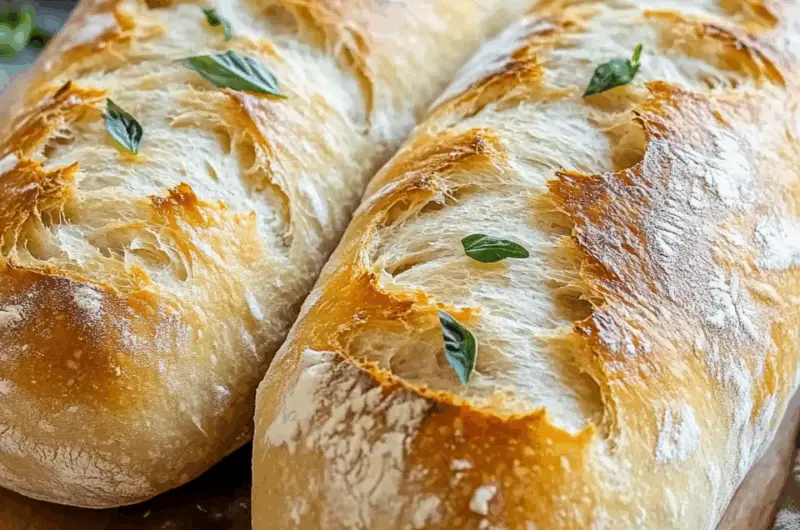Why Crusty Italian Bread Is So Beloved
There’s something uniquely comforting about a crusty loaf of bread. The satisfying crunch of the outer crust, paired with the soft, airy interior, makes every bite a perfect balance of textures. The simple ingredients in this recipe—flour, yeast, water, and salt—combine to create a bread that is rich in flavor and satisfying without being overly heavy.
This bread can be used in countless ways, from being served alongside your favorite pasta dish to being transformed into a delicious sandwich. The chewy crumb and crisp crust are ideal for soaking up sauces or dips, making it the perfect bread for meals like stews, soups, or salads. It’s also delicious on its own, simply sliced and served with butter or drizzled with olive oil for a quick and easy snack.
The Simplicity of the Ingredients
One of the reasons this crusty Italian bread is so popular is its simplicity. The recipe calls for only four ingredients: all-purpose flour, instant yeast, salt, and warm water. The combination of these basic pantry staples creates a loaf of bread that has a deep, savory flavor and a satisfying texture.
Using high-quality ingredients, like good flour and fresh yeast, is essential to the success of the bread. Instant yeast is ideal for this recipe because it doesn’t require proofing in water, making the process quicker and easier. The warm water helps activate the yeast and kick-starts the fermentation process, while salt enhances the overall flavor and controls the yeast’s activity to prevent over-rising.
This minimalist approach to ingredients allows the bread’s natural flavors to shine, and the result is a loaf that is simple yet full of character.
Step-by-Step Process of Making Crusty Italian Bread
While making crusty Italian bread requires some patience, it’s a relatively simple process with just a few key steps: mixing, rising, shaping, and baking. Here’s a brief breakdown of the steps involved in making this delicious homemade bread:
-
Prepare the Dough: Start by combining the flour, yeast, and salt in a large bowl. Gradually add warm water to form a sticky dough, mixing with a wooden spoon. The dough should come together, but it will be slightly sticky to the touch.
-
First Rise: Once the dough is formed, cover it with plastic wrap or a damp towel, and let it rise in a warm area for 1-2 hours, or until the dough doubles in size. This rise allows the yeast to work its magic, creating air pockets in the dough that will give the bread its light, chewy texture.
-
Shape the Dough: After the dough has risen, transfer it to a lightly floured surface and shape it into a round loaf. Be careful not to overwork the dough at this stage, as you want to preserve the air pockets that have formed. Place the shaped dough onto a piece of parchment paper for easy transfer.
-
Second Rise: Cover the shaped loaf with a towel and let it rise for another 30 minutes. During this time, preheat your oven to 450°F and place a Dutch oven inside to heat. The preheated Dutch oven helps create a steamy environment inside the bread, which is key to achieving the perfect crust.
-
Bake the Bread: Once the oven and Dutch oven are hot, carefully transfer the dough (with parchment paper) into the preheated Dutch oven. Cover it and bake for 30 minutes. After 30 minutes, remove the lid and bake for an additional 10-15 minutes to allow the crust to develop a golden brown color.
-
Cool and Serve: Once the bread has finished baking, remove it from the oven and let it cool on a wire rack before slicing. This cooling period helps set the texture of the bread and prevents it from becoming too doughy when sliced.
Tips for Perfect Crusty Italian Bread
Making homemade bread doesn’t have to be intimidating, but there are a few tips that can help ensure your loaf turns out perfectly every time:
-
Use a Dutch Oven: The key to getting that signature crusty exterior is using a Dutch oven or a similar covered baking vessel. The enclosed environment traps moisture and creates steam, which results in a crispier crust.
-
Don’t Skip the Rise Time: Allowing the dough to rise properly is essential for achieving the right texture. If you try to rush this process, the bread may turn out dense rather than light and chewy. Be patient, and give the dough time to double in size during both rises.
-
Preheat Your Oven: Make sure your oven is fully preheated to 450°F before baking the bread. The high temperature is necessary for developing the crisp crust and ensuring that the inside of the bread cooks evenly.
-
Use Parchment Paper: For easy transfer, place the dough onto parchment paper before placing it into the Dutch oven. This helps avoid sticking and makes it easier to remove the bread once it’s baked.
The Versatility of Crusty Italian Bread
Crusty Italian bread is incredibly versatile and can be used in a variety of ways. It pairs perfectly with soups, salads, and pasta dishes, providing a hearty base to soak up delicious broths and sauces. Additionally, it can be sliced and toasted, then served with butter, olive oil, or garlic for an easy snack.
It’s also perfect for making sandwiches, as the crust adds texture and flavor to every bite. Whether you’re using it for a classic Italian sub or just enjoying it with some cheese and deli meats, crusty Italian bread is the perfect vessel for any filling.
Nutritional Information
Crusty Italian bread is a simple and satisfying food, providing essential carbohydrates and a small amount of protein. A single slice of this bread contains about 140 calories, 1g of fat, 28g of carbohydrates, and 4g of protein. It also provides 1g of fiber, helping to keep you fuller for longer. While it’s not particularly high in fat or sugar, it’s a delicious and wholesome addition to any meal.
Conclusion
Crusty Italian bread is a timeless recipe that brings the warmth and aroma of freshly baked bread into your home. With its golden, crispy crust and soft, chewy interior, it’s the perfect bread to serve with a variety of dishes or to enjoy on its own. This beginner-friendly recipe is simple to follow, and with just a little patience, you’ll have a homemade loaf that rivals anything from a bakery.
Whether you’re a seasoned baker or a complete beginner, this crusty Italian bread recipe is a great way to hone your bread-making skills while enjoying the satisfaction of creating something truly delicious. Enjoy it fresh from the oven or toasted with your favorite spreads—it’s a versatile and tasty addition to any meal.








